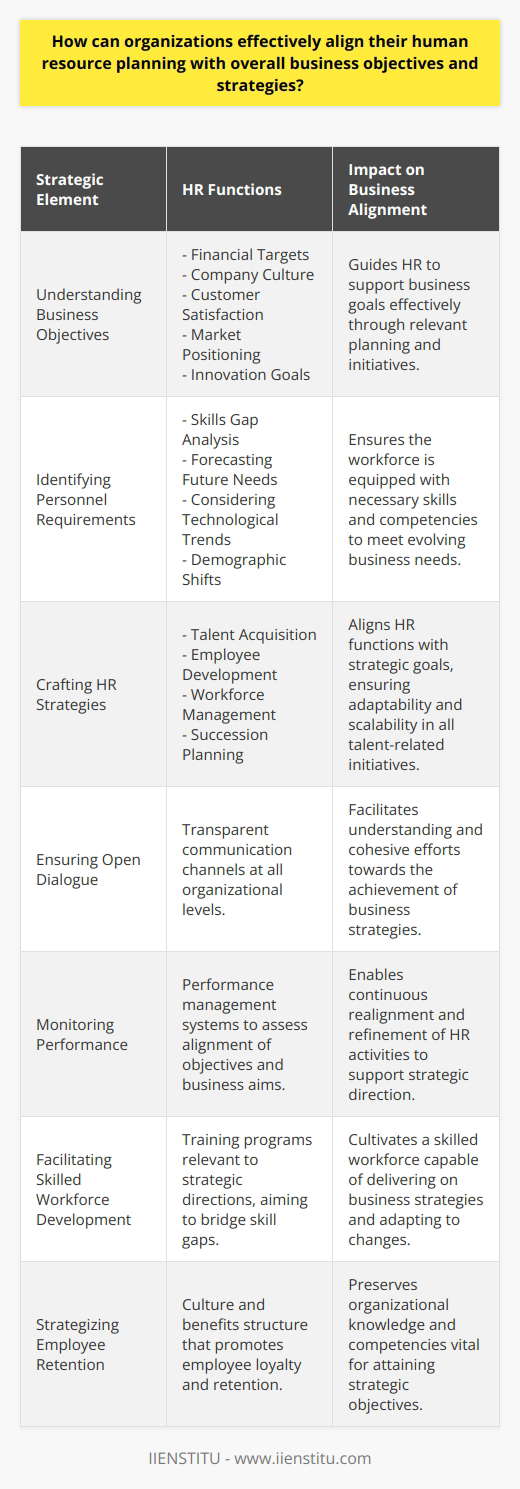
We all know that people are a key asset to any business. With the right Human Resources Planning, you can effectively allocate and develop your human resources to maximum effect. HR planning involves understanding the skills and capabilities of individuals in order to maximize their potential in achieving organizational objectives.
In this blog post, we'll explore how best to predict the performance of employees through informed HR planning, highlighting important steps such as identifying available talent, analysing employee strengths and weaknesses, aligning workers with key tasks, developing plans for improving worker competency and measuring staff effectiveness.
Let's take a closer look at how Human Resources Planning can help your business optimize its output!
What is Human Resources Planning (HRP)?
Human resources planning (HRP) is a process used to identify an organization’s staffing needs. It involves forecasting future labor requirements, developing strategies to meet those needs, and taking proactive measures to ensure the organization has enough staff with the right skills to meet its objectives.
This article will explain what HRP is, why it is important, and how it can be implemented effectively.
What Is HRP?
HRP is a systematic approach used by organizations to manage their workforce. It involves making sure that the right people with the right skills are in place when needed. The goal is to enable the organization to meet its strategic goals by having a sufficient number of qualified employees.
This can be done through recruitment, training, succession planning, job redesigning, and other practices designed to optimize an organization’s human capital resources.
HRP helps organizations plan for changes in the workplace such as technological advances, economic trends, changing customer demands, new regulatory requirements, etc., so that they can remain competitive and successful. It also helps organizations create effective organizational structures which enable them to utilize their human capital more efficiently.
Why Is HRP Important?
In today’s rapidly evolving business environment, HRP is essential for organizations looking to stay ahead of the competition. By anticipating future staffing needs and identifying potential gaps between current staff capabilities and those needed in the future, organizations can take proactive steps to attract and retain talented employees who are well-suited for their environment and have the necessary skillset for meeting their goals.
Additionally, HRP helps ensure that there are no shortages or excesses in staffing levels which could lead to costly mistakes or ineffective operations. Lastly, HRP provides an opportunity for organizations to assess their current workforce composition so they can better identify areas where additional training or retraining may be beneficial or necessary in order for them remain competitive.
How Can I Implement HRP In My Organization?
Implementing an effective HRP strategy requires careful consideration of several factors including budget constraints; availability of talent; organizational culture; legal considerations; etc.
Additionally, it requires executives and managers within the organization work together closely in order to identify current staffing requirements as well as any potential areas where additional support may be needed in order to achieve their objectives.
Once these areas have been identified then measures must be taken such as recruiting new employees or providing existing employees with additional training opportunities so they can acquire new skillsets which may be necessary for meeting organizational goals going forward.
Human resources planning (HRP) is an essential part of any successful business strategy because it enables organizations to anticipate future staffing needs while ensuring that they have enough qualified personnel with the required skillsets needed for meeting their objectives now and into the future.
By taking proactive steps such as conducting thorough assessments of current staff capabilities; recruiting new talent; providing existing staff with additional training opportunities; etc., businesses can ensure that they have a well-prepared workforce capable of meeting even their most ambitious goals going forward.
The three steps of HRP
Human Resource Planning (HRP) is a process that involves identifying and anticipating the needs of an organization's workforce in order to ensure the right people are in the right places at the right time. By using this approach, organizations can effectively manage their talent and ensure their overall success. Let’s explore HRP and its three main steps.
Analyzing Current Resources
The first step of HRP is analyzing current resources. This involves taking inventory of existing staff, as well as assessing their skills and experience levels. Organizations should also take into account any external factors such as changes in technology or shifts in the market that could affect their ability to attract and retain talent. This step will provide a clear understanding of what resources are available, allowing for more informed decisions about how to use them.
Identifying Future Needs
The second step of HRP is identifying future needs. This involves forecasting your organization's future staffing requirements, taking into account any changes anticipated within both the internal and external environment. This includes looking at things like new technologies, changes in customer preferences, or shifts in the labor market that might impact your ability to meet demand.
This step allows organizations to anticipate staffing needs so they can plan ahead and make sure they have sufficient resources when needed.
Developing Strategies
The third step of HRP is developing strategies for meeting those identified needs. This involves creating an action plan that outlines how you will address any gaps between the current available resources and the desired outcomes for recruitment, training, or retention goals. It’s important to consider both short-term and long-term strategies when developing these plans so you can adjust quickly if needed while still having a clear vision for achieving your goals over time.
HRP is an essential process for managing talent within an organization. By taking inventory of existing resources, identifying future needs based on forecasted trends, and developing strategies for meeting those identified needs, organizations can effectively manage their workforce in order to achieve their desired outcomes now and into the future.
If you’re looking for ways to successfully optimize your talent management practices, implementing a Human Resource Planning system may be just what you need!
Calculating the potential of your workforce
Human Resources (HR) planning is a crucial component of any business. It helps you to quickly identify top talent and develop strategies that increase the potential of your current workforce. HR Planning allows you to make sure all employees are working at their highest capacity and that they have the resources they need to do their job well. By understanding the potential of your workforce, you can improve employee engagement and morale and increase productivity in the workplace.
Assessing Your Current Workforce
The first step in maximizing your workforce potential is to assess what you already have on hand. Take a look at your current staff, evaluate their skillset, strengths, weaknesses, and experience. This assessment will allow you to determine who needs additional training or mentorship to maximize their potential within the organization. It also serves as a way for managers to recognize top performers and reward them accordingly.
Identifying Potential Leaders
Another important part of HR planning is identifying potential leaders within your organization. This can be done through an individual evaluation process that takes into account each person’s skillset, qualifications, experience, history with the company, and other factors such as personality traits or leadership abilities. By focusing on both current performance and future potential, employers can better understand which employees have the greatest chance of becoming successful leaders within the organization.
Related Course: Leadership Development Course
Developing a Training Program for Employees Once you’ve identified those with leadership potential, it’s time to create a training program that will help them reach their full potential. A comprehensive training program should include activities such as seminars or workshops focused on developing specific skill sets or providing additional knowledge related to management or leadership roles within the company.
The goal is to provide employees with all the tools necessary for success in their current role and prepare them for any future positions they may take on down the line.
With proper HR planning, employers can effectively identify top talent and create strategies that allow them to maximize the potential of their work force. By assessing current staff members and identifying those with leadership qualities, businesses can create targeted training programs that help employees reach new heights while simultaneously increasing overall productivity in their organization.
Human Resources planning allows businesses to stay one step ahead by recognizing talented individuals before they become invaluable assets within an organization - a key factor when it comes to staying ahead of competitors in today's market place!
Limitations and considerations
Although Human Resources planning can be a powerful tool for optimizing talent management practices, it is important to remember that there are certain limitations and considerations when utilizing this system.
First and foremost, HR planning requires an accurate assessment of current staff members as well as reliable forecasting of future trends in the market. Without up-to-date information about the workforce, it can be difficult to make informed decisions about training programs or hiring new employees.
Additionally, HR Planning relies heavily on data from past performance which may not accurately reflect how individual employees will perform in the future.
Putting it all together
HR Planning is an essential component of any successful business. By assessing current staff members, identifying potential leaders, and developing targeted training programs businesses can maximize their workforce potential and ensure the success of their organization.
Human Resources planning can be a powerful tool, however it must be utilized with consideration for limitations such as limited data availability or forecasting errors when predicting future performance.
With proper Human Resource Planning businesses can stay ahead of competitors while also creating an environment that rewards hard work and encourages growth within the company.
Sample Calculation
To illustrate Human Resources Planning in practice, consider a company with 30 employees working within three different departments (Marketing, IT, and Operations). The HR Manager has identified five employees as having leadership qualities which could contribute to the overall success of the business. The manager then creates a training program designed to help those individuals reach their full potential in their current roles and prepare them for future management positions. Finally, the HR manager would need to calculate the potential increase in productivity that could be achieved by providing these five employees with further development opportunities.
In this example, the estimated increase in productivity can be calculated by analyzing the current productivity of all 30 employees and the expected productivity of those with leadership qualities when they have completed their training program.
By multiplying the total number of hours worked each week (30 x 40) and subtracting that from the projected hours of increased productivity (5 x 50), you can determine an estimate of how many more hours can be generated per week (1500 - 250 = 1250). This calculation provides an approximate value for Human Resources Planning efforts and helps businesses understand which employees have the greatest chance of contributing to their success.
In conclusion, Human Resources Planning is an essential tool for businesses hoping to maximize their workforce potential and stay ahead of competition. By assessing current staff members and developing targeted training programs, businesses can identify talented individuals who are capable of taking on leadership roles while also increasing overall productivity throughout the organization.
Although there are certain limitations and considerations when utilizing Human Resources planning, if done correctly it can be a powerful tool for driving significant increases in productivity. Through proper Human Resource Planning businesses can reach new heights by rewarding hard work and encouraging growth within the company.

Frequently Asked Questions
How can I identify gaps in my human resources planning?
Analyze your current workforce and skillset.
Review your organization’s strategic goals and objectives.
Identify any skills or roles that are needed to achieve those goals.
Compare the skills of your current employees to those needed to achieve the goals.
Assess the availability of qualified external candidates in the job market.
Consider the potential impact of automation and other technological advancements.
Create a plan to fill any identified gaps in human resources.
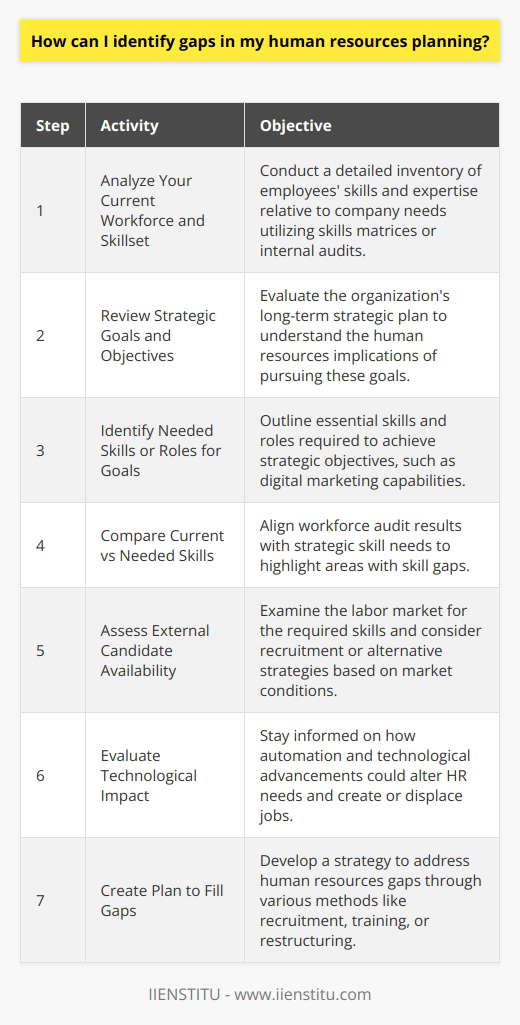
What methods can I use to calculate the potential of my workforce?
Analyze job performance data.
Conduct employee surveys.
Use 360-degree feedback.
Observe employee behavior.
Assess job competencies.
Develop a talent management strategy.
Analyze job descriptions.
Develop job performance standards.
Utilize job satisfaction surveys.
Implement employee training and development programs.
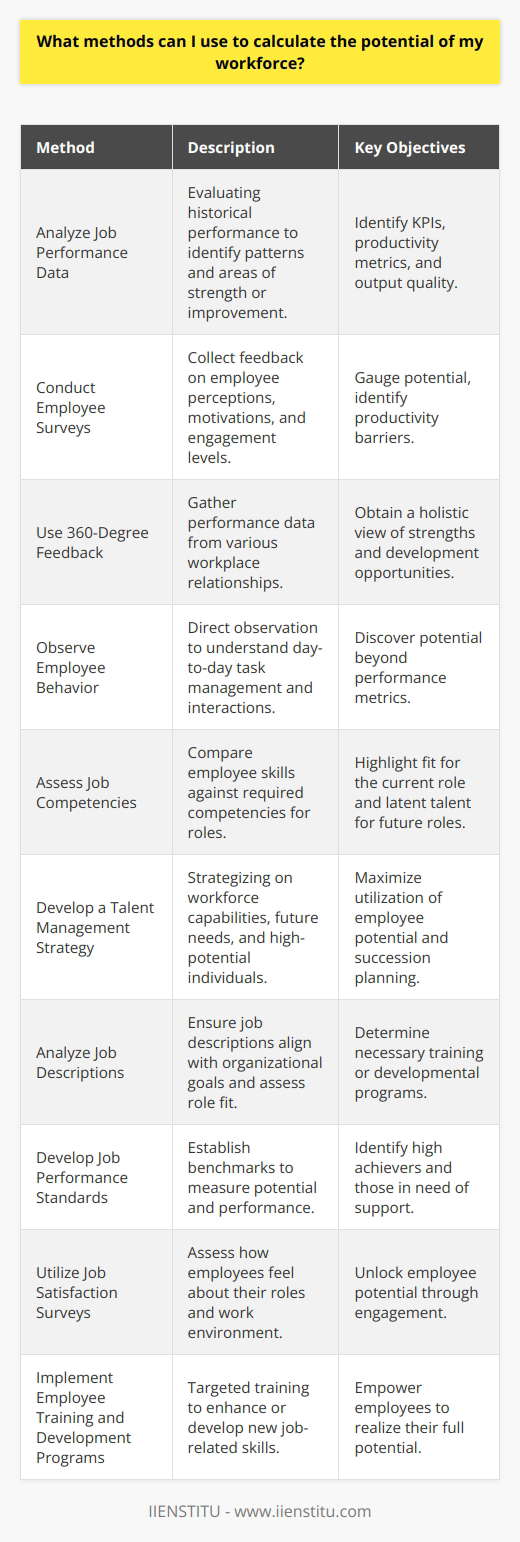
What best practices should I consider when implementing a human resources planning strategy?
Develop clear objectives for the HR planning strategy.
Take into account the current and future needs of the organization.
Analyze the current workforce and determine the existing skill sets.
Identify potential gaps in the workforce and develop a plan to address them.
Establish a timeline for achieving goals and objectives.
Engage stakeholders in the planning process.
Consider the impact of technology on HR planning.
Monitor performance and adjust strategies as needed.
Evaluate and assess the effectiveness of HR planning strategies.
Ensure legal compliance with all applicable laws and regulations.
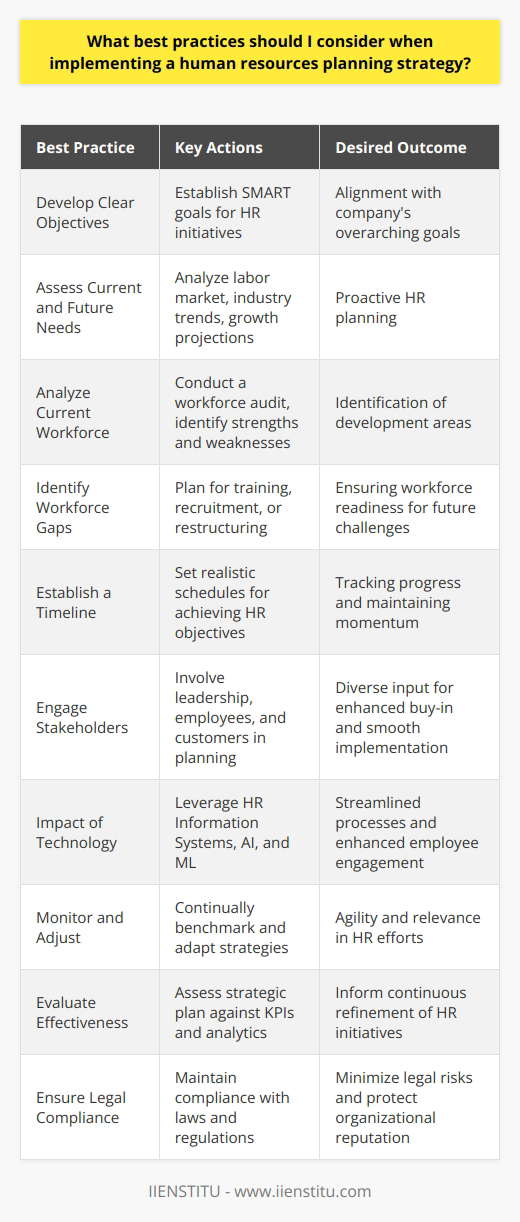
What is workforce analysis in human resource planning?
Understanding Workforce Analysis
Workforce analysis is a vital part of human resource planning that focuses on understanding the current state of an organization's workforce. It evaluates the employees' competencies, level of experience, and skillsets, and compares them with the anticipated workforce requirements to achieve the organization's objectives.
Significance of Workforce Analysis
The primary goal of this analysis is to identify the workforce gaps and develop strategies to bridge them. It helps in making informed decisions regarding recruitment, training, and employee retention. Workforce analysis is important for organizations to maintain their competitiveness and adapt to changing business environments.
Methods of Workforce Analysis
Several techniques are used to conduct a workforce analysis, which can be categorized into quantitative and qualitative methods. Quantitative methods involve the use of data and statistics, such as turnover rates, headcount, and demographics. Qualitative methods are more subjective and involve assessing employee skills, job satisfaction, and future career aspirations.
Key Components
Workforce analysis typically consists of three main components: supply analysis, demand analysis, and gap analysis.
Supply Analysis: This involves evaluating the current workforce and identifying its strengths and weaknesses. This can include assessing employee skills, work experiences, qualifications, and job performances.
Demand Analysis: This requires an understanding of the organization's strategic objectives and determines the type of workforce needed to meet those objectives. This includes forecasting staffing needs based on industry trends, technology advancements, and market conditions.
Gap Analysis: This compares the current workforce supply with the predicted demand, identifying any skill gaps or labor shortages that need to be addressed.
Strategic Intervention
After identifying the gaps, organizations can develop and implement strategic interventions to address workforce challenges. These may include targeted recruitment efforts, training and development programs, succession planning, or restructuring initiatives. By aligning human resource strategies with organizational objectives, companies can ensure they have the right talent in place to drive growth and success.
In conclusion, workforce analysis plays a crucial role in human resource planning by providing organizations with valuable insights into their workforce's current state and future needs. It enables better decision-making around recruitment, employee development, and staff retention, ultimately contributing to the overall success of the organization.
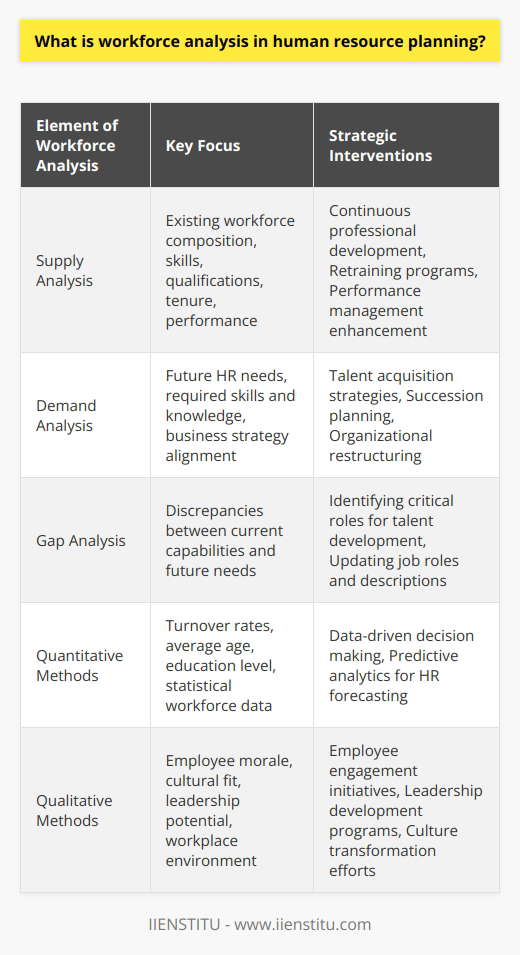
How do you measure workforce planning?
Defining Workforce Planning Metrics
Workforce planning is the strategic alignment of an organization's human resources to effectively meet present and future business goals. To measure workforce planning, several key metrics must be considered, as discussed below.
Workforce Headcount Analysis
Headcount analysis provides an overview of the organization's current workforce, illustrating the number of employees, their distribution across demographic groups, departments, and hierarchical levels. This allows for the identification of trends, gaps, and areas requiring adjustments to achieve optimal staffing levels.
Hiring Effectiveness
Hiring effectiveness evaluates the organization's ability to recruit and select the right talent for specific roles. Metrics such as time-to-fill, cost-per-hire, and the quality of hire can be indicative of the effectiveness of an organization's recruitment strategy and hiring process.
Turnover Rates and Retention
Understanding employee turnover rates, calculated as the percentage of employees leaving the organization within a given period, is crucial to assess workforce stability. Comparing turnover and retention rates between different departments and roles can help reveal potential problems or areas for improvement within the organization.
Employee Engagement
The level of employee engagement directly impacts productivity, retention, and overall performance. Engagement can be measured through employee surveys, feedback tools, or performance evaluations, allowing the organization to gauge employee satisfaction and identify any underlying problems that may affect workforce planning.
Succession Planning
Effective succession planning ensures that an organization has identified and developed employees needed to fill future critical roles. Metrics such as readiness assessments, skill gap analyses, and the percentage of filled key positions can help determine the success of a company's succession planning strategy.
Training and Development
Investments in employee training and development are essential to maintain a skilled and competent workforce. Metrics such as training hours per employee, development program participation rates, and impact on performance can provide insights into the success and relevance of these efforts.
In conclusion, measuring workforce planning involves assessing factors such as headcount analysis, hiring effectiveness, turnover rates, employee engagement, succession planning, and training and development initiatives. By evaluating these key metrics, organizations can make informed decisions that ensure optimal workforce alignment and greater success in meeting their business objectives.

What are the 3 key areas of human resources planning?
Key Area 1: Workforce Planning
A crucial component of human resources planning involves workforce planning, which aims to create a balance between an organization's needs and the available talent pool. By assessing current and future staffing requirements, HR professionals can align their hiring strategies with the organization's strategic goals. This includes evaluating the skill sets, experience, and knowledge that employees possess and identifying areas where there may be gaps. Workforce planning allows organizations to proactively address these gaps, either by training existing employees, recruiting new talent or implementing succession planning to ensure a smooth transition of leadership.
Key Area 2: Talent Development
Another critical aspect of human resources planning is talent development. This process takes a comprehensive approach to developing the knowledge and abilities of employees, with the intention of improving their overall performance and contribution to the organization. Talent development can include employee training programs, mentorship initiatives, and promoting ongoing professional development to ensure that staff members have access to the necessary resources to grow and succeed in their roles. Investing in enhancing the skill sets of employees not only benefits the individuals but also contributes to the overall success and competitiveness of the organization.
Key Area 3: Compensation and Benefits Planning
The third key area in human resources planning involves designing and managing a comprehensive compensation and benefits package that meets the needs of the organization's workforce while remaining competitive in the job market. This includes creating salary benchmarks, evaluating employee performance for decisions related to promotions or raises, and ensuring that the company provides a competitive benefits package to attract and retain top talent. Structuring these plans requires an understanding of market conditions, industry trends, and internal equity considerations, ensuring fair and just compensation for all employees. In turn, this contributes to improved employee satisfaction, motivation, and ultimately, organizational success.
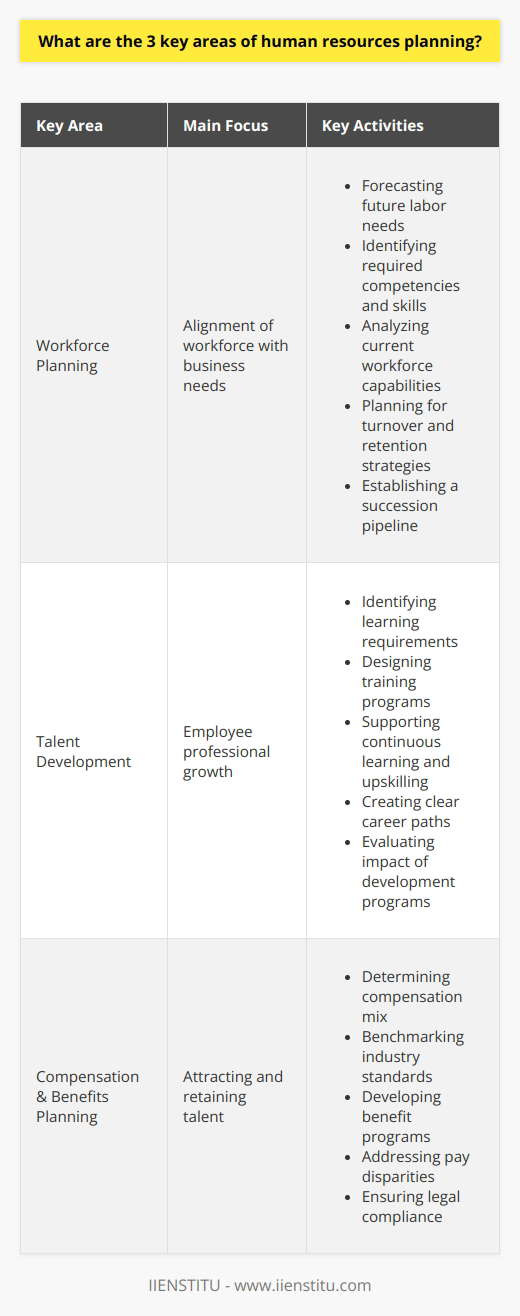
How do you calculate workforce capacity?
Understanding Workforce Capacity
To accurately calculate workforce capacity, it is essential to consider several factors that contribute to an organization's overall productivity levels. First, a thorough understanding of the number of employees available for the given period must be established.
Evaluating Employee Availability
Employee availability comprises full-time and part-time employees, as well as potential temporary workers and overtime hours. Information regarding each employee's work schedule, vacation or sick leave requests, and additional, non-project-related responsibilities must also be taken into account. This labor availability data is critical when determining the organization's capacity to meet workload demands.
Assessing Employee Skills and Productivity Rate
Next, assessing the skills and proficiency of each employee is pivotal to calculating workforce capacity. Through this evaluation, employees can be matched to specific tasks and responsibilities that correspond to their skills and expertise, ensuring optimal productivity levels. Additionally, individual productivity rates can be determined through historical data, performance reviews, or benchmarks for similar roles. These productivity rates are essential for projecting the total output level of a team or department.
Calculating Workforce Capacity
Once labor availability, skills assessment, and productivity rates are determined, workforce capacity can be calculated using the following formula:
Workforce capacity = total available hours x employee productivity rate
This calculation enables organizations to project the amount of work that employees can achieve within the given timeframe. By doing so, an organization can make informed decisions regarding staffing levels, project assignments, and other resources necessary to meet production goals.
Adjusting Capacity for Fluctuations and Variations
It is important to remember that workforce capacity is not a static metric. Variability in labor availability, worker productivity, and changes in project scope will require ongoing adjustments to capacity calculations. Regularly reviewing these factors and making necessary adjustments is crucial for maintaining efficiency and meeting workload demands.
In conclusion, calculating workforce capacity involves a multidimensional approach that considers employee availability, individual skills, and productivity rates. This calculation is essential for making informed decisions on resource allocation and project management within an organization. Furthermore, adjustments should be made proactively to account for fluctuations and variations in the aforementioned factors. By conducting these assessments consistently, organizations can optimize workforce capacity and achieve their productivity goals.
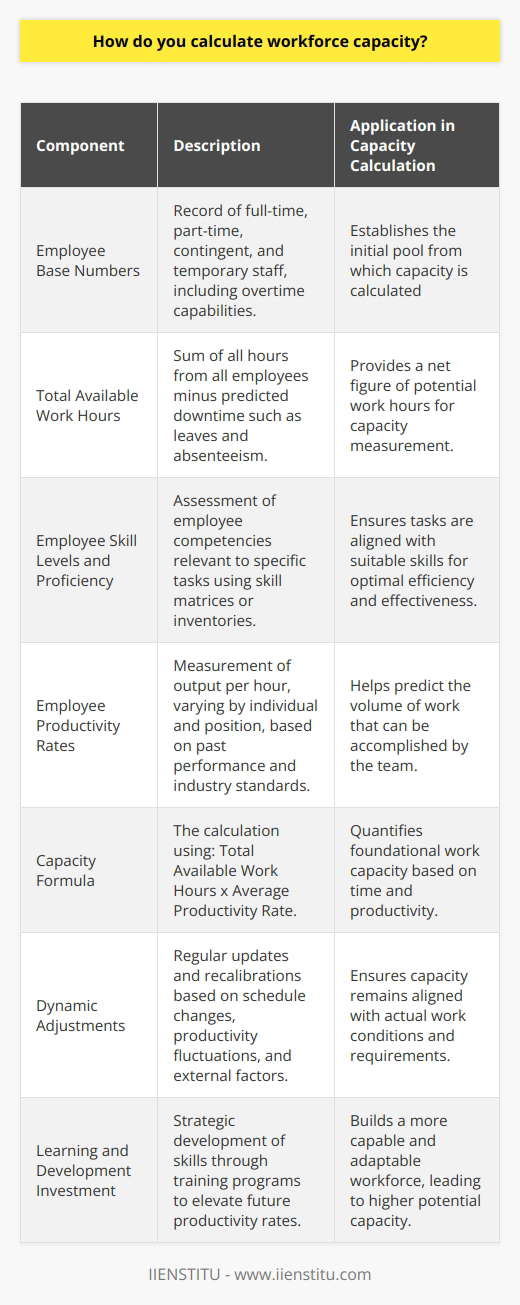
What is workforce analysis in HRP?
Understanding Workforce Analysis
Workforce analysis, a critical component of Human Resource Planning (HRP), refers to the process of evaluating an organization's workforce to identify gaps and anticipate future staffing requirements. It involves collecting, analyzing, and forecasting workforce data, including turnover rates, skill sets, and demographic profiles, to mention a few.
Key Steps of Workforce Analysis
Data Collection: Gathering comprehensive data on the current workforce, such as job roles, responsibilities, experience, education, performance levels, and other relevant information.
Data Analysis: Examining collected data to determine the strengths and weaknesses of the organization's workforce, focusing on skill gaps and areas requiring improvement.
Workforce Forecasting: Predicting future workforce requirements through factors such as attrition rates, technological advancements, and the organization's strategic goals.
Developing Action Plans: Identifying necessary actions, such as recruitment, training, or restructuring, to address workforce gaps and fulfill future staffing needs.
Benefits of Workforce Analysis in HRP
Workforce analysis serves several vital functions within HRP. For one, it helps organizations align their HR strategies with their broader business objectives. By understanding current workforce capabilities and forecasting future needs, organizations can more effectively plan for and address changes in a rapidly evolving, competitive landscape.
Moreover, workforce analysis assists with talent management, ensuring that organizations can attract, retain, and develop the skills and expertise necessary for success. Identifying skills gaps and areas with high turnover enables HR professionals to devise targeted recruitment and retention strategies, ultimately bolstering overall organizational performance.
Finally, workforce analysis plays a key role in promoting diversity and inclusion within the workplace. By examining the demographic composition of the workforce, organizations can work towards fostering a more inclusive environment, enhancing employee satisfaction, productivity, and innovation.
Challenges and Limitations
Despite its benefits, workforce analysis also presents challenges. The accuracy of the analysis depends on the quality and comprehensiveness of data collected, which may be limited by inconsistent or incomplete information. Additionally, forecasting future workforce requirements necessitates an ability to predict various external factors, such as economic conditions and technological advancements, which can be unpredictable.
In conclusion, workforce analysis is an essential aspect of HRP, enabling organizations to gauge their workforce's strengths and weaknesses, predict future staffing needs, and develop strategic initiatives that address identified gaps. While it is not without challenges, effective workforce analysis can significantly contribute to organizational success by fostering talent development, workplace diversity, and strategic alignment.
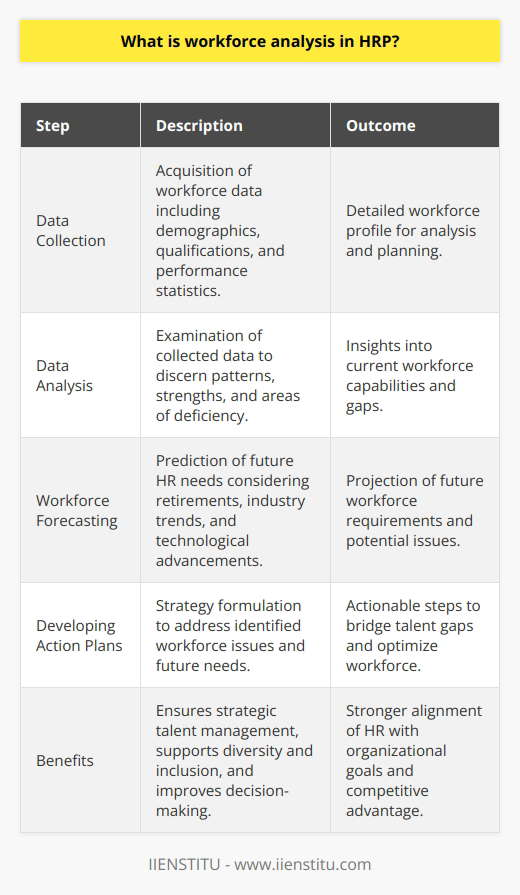
What are the 3 key areas of human resources planning?
Key Area 1: Workforce Planning
Workforce planning is an essential component of human resources planning to ensure that organizations have the right employees with the necessary skills, knowledge, and abilities to achieve their objectives. This process involves determining current and future workforce needs, analyzing existing employee skills, and identifying skills gaps. Organizations then develop strategies to address these gaps through recruitment, training, and development initiatives. This proactive approach to workforce management helps organizations to adapt to changing market conditions, improve employee retention, and create a more flexible and competitive workforce.
Key Area 2: Talent Management
Another critical area in human resources planning is talent management, which entails the systematic identification, development, and retention of high-performing employees. By investing in talent management programs and processes, organizations can increase their overall performance and competitiveness by drawing on the full potential of their employees. This process includes various efforts, such as employee recognition, performance management, succession planning, and career development. Effective talent management helps businesses to improve employee satisfaction, enhance organizational culture, and foster a healthy work environment, ultimately contributing to long-term organizational success.
Key Area 3: Risk Management and Compliance
Risk management and compliance are vital components of human resources planning as they aim to minimize legal and reputation risks associated with employment practices. This area involves monitoring and complying with a wide range of labor laws, regulations, and industry standards, which can be complex and ever-changing. These can include matters related to employee health and safety, equal employment opportunities, and data privacy. To ensure adherence, HR professionals must develop policies, procedures, and training programs that promote a culture of compliance within the organization. By effectively managing risks and compliance, organizations can avoid costly penalties and potential damage to their reputation while fostering a positive work environment for all employees.
In conclusion, human resources planning plays a crucial role in driving organizational success by ensuring a skilled, productive, and compliant workforce. Focusing on workforce planning, talent management, and risk management and compliance allows organizations to stay competitive, adapt to change, and promote a healthy work environment. By addressing these key areas, HR professionals can directly contribute to the achievement of the organization's overall strategic objectives.

What are the 5 key elements of workforce planning?
**Introduction to Workforce Planning**
Workforce planning is an essential process that enables organizations to have the right people in the right roles at the right time, ensuring an effective and skilled workforce. There are five key elements of workforce planning that organizations should consider as they develop and implement their strategies.
**Assessing Current Workforce**
The first element involves conducting an assessment of the organization's existing workforce, including their skills, abilities, and performance history. This evaluation provides a solid foundation for identifying gaps, modifying employee roles, and determining the overall human resource needs of the company.
**Forecasting Future Needs**
The second element of workforce planning is forecasting future human resource requirements. This involves estimating the number of employees with the necessary skills and qualifications needed within the organization over a certain period. Factors such as changes in technology, demographic shifts, and industry trends should be considered when making these projections.
**Developing Talent Strategies**
The third key element of workforce planning is the development of talent strategies to address identified gaps and ensure the organization's future success. These strategies may include recruiting new employees, retaining experienced professionals, developing internal talent, or retraining existing staff for new roles. Companies must be flexible in their approach to cater to evolving business requirements.
**Implementing Workforce Plans**
The fourth element within workforce planning is the implementation of the plans and strategies developed throughout the process. This involves working collaboratively with managers and employees to communicate expectations and monitor progress, ensuring a successful transition during any changes in the organization.
**Evaluating and Adjusting Workforce Plans**
Lastly, organizations must continuously monitor and evaluate their workforce plans to ensure they remain effective in meeting the changing demands of the business environment. This involves analyzing key performance indicators and using the data to make informed decisions regarding adjustments to workforce strategies as needed.
In summary, the five key elements of workforce planning consist of assessing the current workforce, forecasting future needs, developing talent strategies, implementing workforce plans, and evaluating and adjusting strategies as necessary. By considering these key components, companies can ensure they have a skilled, diverse, and adaptive workforce ready to meet current and future challenges.
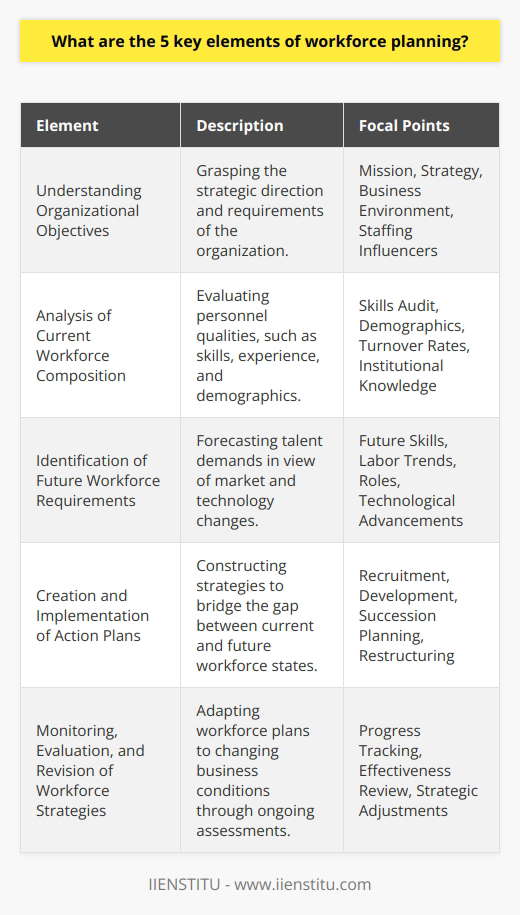
How can human resource planning help in supply and demand of workforce?
Assessing Supply and Demand
Human resource planning plays a crucial role in aligning an organization's workforce with its strategic goals by balancing the supply and demand of talent. This process consists of analyzing the availability of skills within the organization and forecasting any potential shifts in demand for skills. By doing so, human resource planning can identify skill gaps and take proactive steps to address these shortages.
Forecasting Workforce Needs
An essential aspect of human resource planning involves estimating the workforce demand and predicting any changes that may arise in the future. This forecasting assists in determining the required number of employees, as well as the appropriate skill sets. Based on this information, HR can devise workforce strategies, such as recruitment, training, and development initiatives, to ensure an organization has the right people in the right positions.
Inventory of Skills
Identifying the skill potential of the current workforce is a critical step in human resource planning. By conducting talent inventories, HR can establish a comprehensive understanding of employees' abilities and qualifications. This information is useful in identifying the organization's strengths and addressing areas of skill shortage, either through training existing employees or recruiting new ones with the desired competencies.
Retention and Succession Planning
Another means of managing supply and demand in the workforce is through retention and succession planning. By applying effective retention strategies, HR professionals can minimize employee turnover, preserving valuable knowledge and skills. Furthermore, identifying high-potential employees and preparing them for leadership roles ensures a smooth transition when key positions become vacant. This process helps to maintain organizational stability and continuity in times of change.
Adaptability and Agility
Ultimately, one of the primary benefits of human resource planning is enabling organizations to adapt and respond to changing workforce demands. By regularly evaluating and updating workforce plans, HR can ensure that their organization remains competitive in the global marketplace. This adaptability contributes to business success by fostering an agile and prepared workforce that can efficiently meet evolving industry demands.
In conclusion, human resource planning is integral in managing the supply and demand of an organization's workforce. Through sound forecasting, inventory of skills, retention, and succession planning, HR professionals can ensure that businesses are equipped with the right talent to accomplish their objectives. Ultimately, this planning process fosters adaptability and agility, effectively preparing organizations for future workforce challenges.
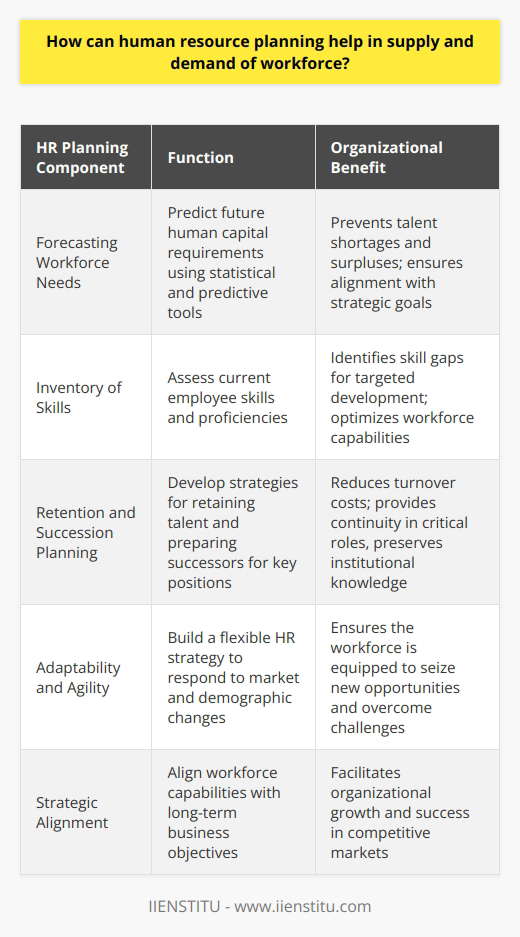
What are the 4 elements of HR planning process?
Elements of HR Planning Process
Workforce Analysis
The first element in the HR planning process is workforce analysis. It involves reviewing the current workforce to determine its composition, size, and skillset. This analysis enables an organization to identify its current talent inventory and workforce gaps, which are essential for setting realistic HR objectives and strategies.
Demand and Supply Forecasting
The second element in HR planning is demand and supply forecasting. This involves estimating the future workforce needs of the organization, including the number and type of employees needed to achieve organizational goals. On the other hand, supply forecasting aims to determine the availability of internal and external talent to meet the future workforce requirements. Both demand and supply forecasting help organizations in shaping their recruitment, selection, training, and development plans.
Development of HR Strategies
The third element in the HR planning process is the development of HR strategies. These strategies address the identified workforce gaps by implementing the necessary policies and programs on recruitment, selection, training, development, and retention. Some common HR strategies include employee engagement initiatives, succession planning, and performance management systems. By aligning HR strategies with organizational objectives, organizations ensure that they have the right human resources to drive their growth and success.
Implementation and Monitoring
Lastly, the HR planning process involves the implementation and monitoring of the developed strategies. HR professionals execute the various initiatives and programs based on the HR strategies while keeping in mind the organization's budget, timeline, and workforce needs. Regular monitoring is essential to measure the effectiveness of the HR strategies and make any necessary adjustments or improvements to achieve the desired workforce outcomes. The HR planning process is continually evolving, striving to optimize the organization's human resources to meet its objectives and support business growth.
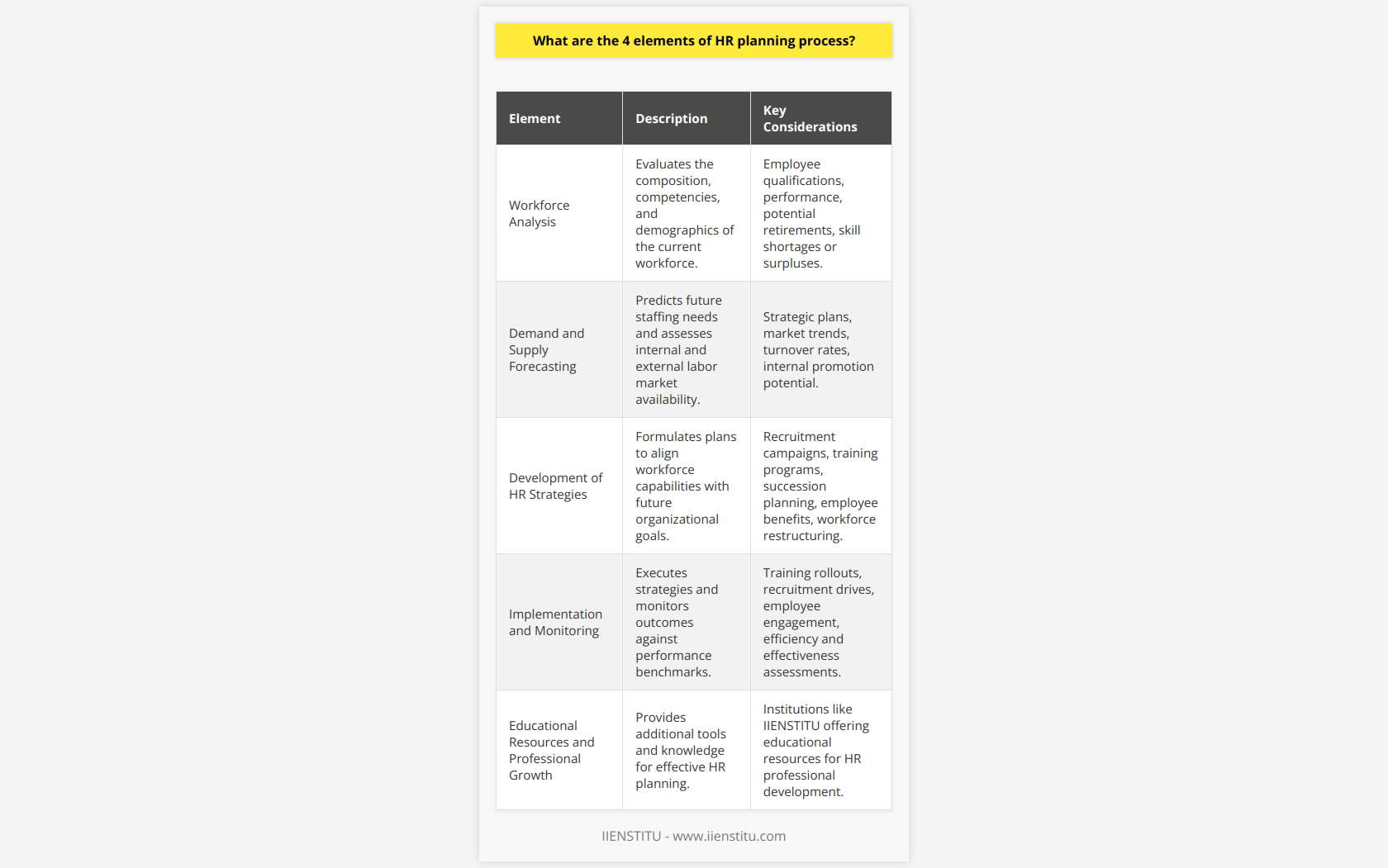
How do you determine future workforce needs?
Analyzing Current Workforce
Determining future workforce needs begins with a close scrutiny of the existing workforce. Assessing competencies, skills, attributes, and potential shortfalls in the current workforce enables forecasting of future demands. A comprehensive skills audit is essential.
Anticipating Organizational Changes
Secondly, anticipate organizational changes forthcoming in the strategic planning process. This encompasses projected expansion, changes in technology, or altering demographics. Deep understanding of future business direction aids accurate workforce needs prediction.
Industry Trends and Economic Predictions
Thirdly, analyze external factors including industry trends and economic forecasts. These influence future workforce needs. Changes in the job market, labor market trends, and industry innovations will affect staffing requirements.
Technological advancements
Technological advancements significantly affect the nature and demand of jobs. Therefore, staying ahead of technological trends and incorporating them into workforce planning is crucial.
Understanding Competitive Landscape
Finally, understanding the competitive landscape aids in predicting future workforce needs. Competitive analysis provides insights into industry standards for skills, competencies, and qualifications. It informs strategies to attract and retain top talents.
In summary, anticipating future workforce needs encompasses a multifaceted approach. This involves internal workforce analysis, considering organizational strategy changes, studying external factors, understanding technological advancements, and competitive industry analysis. This rigorous process is vital for ensuring a company's preparedness and staying competitive in the marketplace.
It requires constant monitoring and adjustment as trends change and the organization evolves. Effectively managing and harnessing workforce resources can significantly transform a company's future. Therefore, it is imperative to not underestimate the importance of determining future workforce needs.
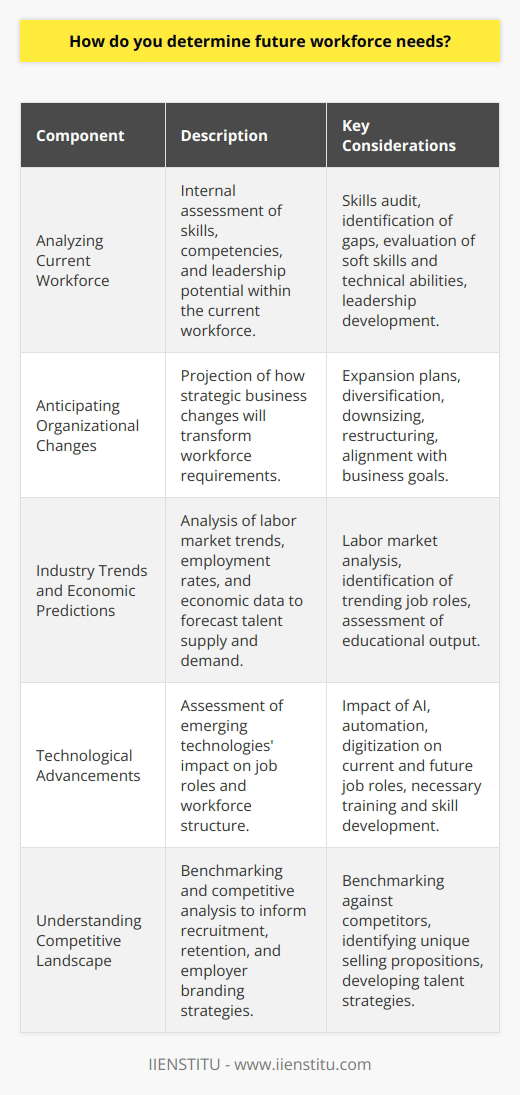
What are the essential components of a comprehensive workforce planning strategy?
Understanding Labour Needs
A comprehensive workforce planning strategy must begin with an understanding of the company's current and future labour needs. This includes identifying current employees' roles, skills, and areas of expertise. Additionally, it involves forecasting future business changes that might alter labour requirements.
Assessing Workforce Environment
Next, the organization should evaluate its internal and external workforce environment. Internally, this entails examining employee turnover rates, retirement plans, and opportunities for promotion or lateral movement. Externally, it involves considering market trends, industry developments and competitive dynamics which might affect recruitment and retention.
Employee Development Strategies
Thirdly, developing strategies for employee growth and enhancement is essential. These could include training programs, mentorship schemes, talent management initiatives, or succession planning strategies. Such programs anticipate future skill requirements, enhance organizational productivity, and increase employee loyalty.
Recruitment and Retention Policies
Finally, it's important to establish effective recruitment and retention policies. Recruitment strategies should align with overall business objectives and involve targeted approaches for diverse candidate groups. Retention policies, meanwhile, are necessary to motivate and retain valuable employees; they may focus on incentives, rewards, or a positive organizational culture.
In conclusion, a comprehensive workforce planning strategy should incorporate a detailed understanding of labour requirements, a careful analysis of the workforce environment, an emphasis on employee development, and strong recruitment and retention policies. By addressing all these aspects, an organization can strategically manage its human resources to achieve its business objectives.

How can organizations effectively align their human resource planning with overall business objectives and strategies?
Understanding Business Objectives
Organizations must first fully understand their overall business objectives. This comprehension forms the basis for aligning human resource planning with business strategies.
Identifying Key Personnel Needs
Identifying key personnel needs is another essential step. HR planners must determine the necessary skills and functions that are crucial to attaining business objectives.
Developing HR Strategies
On this basis, organizations could develop effective human resources strategies. Incongruence between business strategies and HR strategies might undermine the achievement of business objectives. In HR strategies, companies should make provisions for acquiring, developing, motivating, and retaining the required personnel.
Effective Communication
Communication plays a critical role in aligning HR planning and business strategies. Both need to be effectively communicated to all relevant personnel. This ensures everyone is working towards the same goal.
Performance Measurement
To maintain alignment of objectives with HR planning, organizations should regularly measure and evaluate performance. This evaluation allows companies to adjust their strategies accordingly, ensuring alignment with overall business objectives.
Training and Development
Robust training and development programs are also critical. These programs equip employees with necessary skills and competencies relevant to business strategies and objectives.
Employee Retention
Also, organizations need to focus on employee retention strategies. A high turnover rate could signal misalignment of HR planning and business objectives. Keeping turnover rates low could assure effective implementation of business strategies.
To summarize, organizations can effectively align their human resource planning with overall business objectives and strategies through understanding business objectives, identifying key personnel needs, developing HR strategies, emphasizing communication, constantly measuring performance, and implementing strong training, development, and retention strategies. With these techniques, companies can ensure synchronization of their HR planning with their overall strategic objectives.
